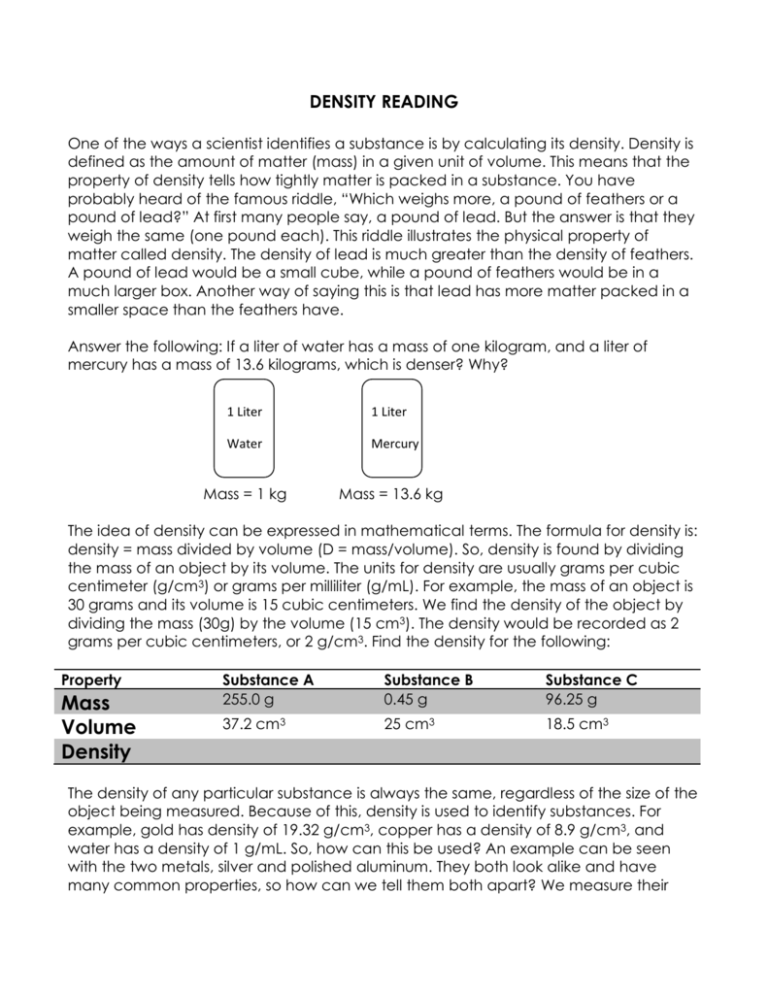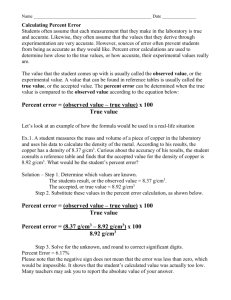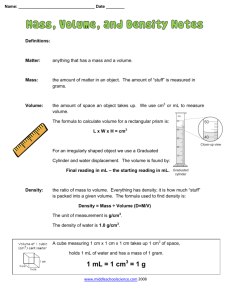density reading - Earth Science Wiki
advertisement

DENSITY READING One of the ways a scientist identifies a substance is by calculating its density. Density is defined as the amount of matter (mass) in a given unit of volume. This means that the property of density tells how tightly matter is packed in a substance. You have probably heard of the famous riddle, “Which weighs more, a pound of feathers or a pound of lead?” At first many people say, a pound of lead. But the answer is that they weigh the same (one pound each). This riddle illustrates the physical property of matter called density. The density of lead is much greater than the density of feathers. A pound of lead would be a small cube, while a pound of feathers would be in a much larger box. Another way of saying this is that lead has more matter packed in a smaller space than the feathers have. Answer the following: If a liter of water has a mass of one kilogram, and a liter of mercury has a mass of 13.6 kilograms, which is denser? Why? 1 Liter 1 Liter Water Mercury Mass = 1 kg Mass = 13.6 kg The idea of density can be expressed in mathematical terms. The formula for density is: density = mass divided by volume (D = mass/volume). So, density is found by dividing the mass of an object by its volume. The units for density are usually grams per cubic centimeter (g/cm3) or grams per milliliter (g/mL). For example, the mass of an object is 30 grams and its volume is 15 cubic centimeters. We find the density of the object by dividing the mass (30g) by the volume (15 cm3). The density would be recorded as 2 grams per cubic centimeters, or 2 g/cm3. Find the density for the following: Property Mass Volume Density Substance A 255.0 g Substance B 0.45 g Substance C 96.25 g 37.2 cm3 25 cm3 18.5 cm3 The density of any particular substance is always the same, regardless of the size of the object being measured. Because of this, density is used to identify substances. For example, gold has density of 19.32 g/cm3, copper has a density of 8.9 g/cm3, and water has a density of 1 g/mL. So, how can this be used? An example can be seen with the two metals, silver and polished aluminum. They both look alike and have many common properties, so how can we tell them both apart? We measure their densities by first finding their mass and volumes and plugging them into our formula for density, and then comparing our answer to the known densities of the metals. Aluminum has a density of 2.7 g/cm3 and silver has a density of 10.49 g/cm3. You can also use density to determine the amount of gold found in a piece of jewelry. Gold alone is too soft to use in the making of jewelry so it is often mixed with copper to make it stronger. This mixture is called an alloy. The gold alloy is not worth as much as pure gold. To determine how much copper is in the gold alloy, you must first find the mass of the jewelry. Then, measure the volume of the jewelry using the water displacement method due to its irregular shape. When the mass is divided by volume, density can be determined. If a piece of jewelry is 50% copper and 50% gold, its density would be 12.22 g/cm3. If its density is less than this, it would have more copper in it than gold. If its density is more than this, it would have more gold in it than copper. A device called a hydrometer measures the density of liquids. A hydrometer is a long, cylindrical glass tube with a small weight at one end. The hydrometer is slowly lowered into the liquid until it floats. The depth to which it sinks depends on the density of the liquid. A scale on the hydrometer is used to read the liquid’s density. Hydrometers can be used to determine information such as the level of milk sugar, alcohol in brewed beverages, or pollutants in water. Another use of density can be found in the sports gym. An athletic trainer can determine the percentage of body fat in an athlete's body. The mass of the athlete is first determined on a scale. He or she is then immersed in a tub of water to determine their volume. The density of the athlete is calculated. If the percent of the body fat is too high, the trainer will recommend a diet and exercise program. Densities also show which objects will float in various liquids. The rule is objects of lower density will float on liquids of higher density. For example, most dry wood is less dense than water, since it has many air pockets. A block of dry wood will, therefore, float in water. If the wood becomes water soaked, the air in the wood is replaced with water. The wood then becomes denser than water and will sink. Density applies to all forms of matter. Seawater is denser than fresh water. Cold air is denser than warm air. Mercury, a liquid, is denser than steel a hard, tough, solid. As you can see, density is an important physical property of matter. Name:____________________________________________ Date:____________ Period:_____ Score:__________/20 Answer the questions below using your own words (UYOW). 1. Define density. 2. What is the mathematical formula for density? 3. Which is more dense, a pound of rice or a pound of cement? Explain your answer. 4. How is density used to identify substances? 5. Will a two liter bottle of coke have a different density than a one liter bottle of coke? Explain your answer. 6. If a jeweler was trying to sell you a bracelet that he said was an alloy of 50% copper and 50% gold, how could you be sure that this was correct? Explain your answer. 7. An object with a density of 1.12 g/cm3 is placed in salt water that has a density of 1.35 g/mL. Will it sink or float? 8. If you are going to carry 2 L of water on hike, and the water has a density of 1 kg/L, how much will it weigh?






